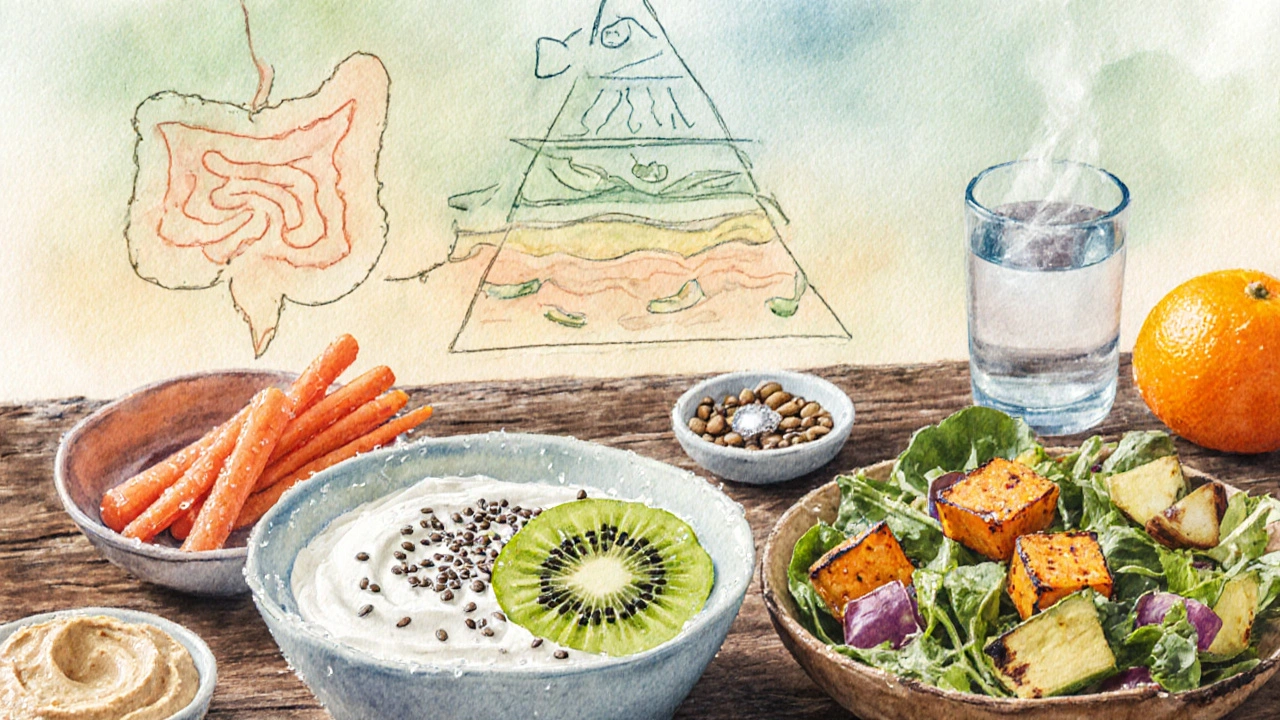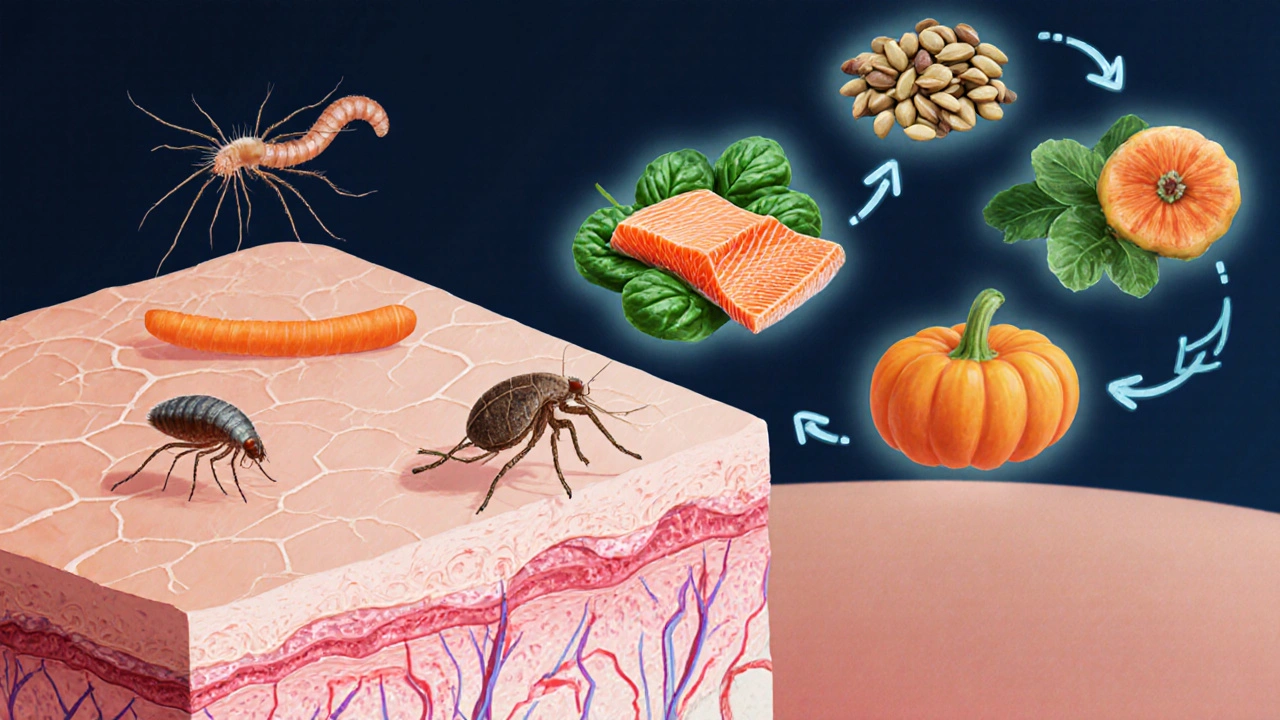Skin Parasite Prevention Nutrition Calculator
Key Nutrients for Skin Parasite Prevention
Vitamin A
Strengthens skin epithelium and mucosal immunity
Recommended: 700-900 mcg
Omega-3s
Anti-inflammatory and improves skin barrier
Recommended: 250-500 mg
Zinc
Supports wound healing and immune function
Recommended: 8-11 mg
Your Personalized Nutrition Plan
Enter your details and click "Calculate My Nutrition Plan" to see your personalized recommendations.
Key Takeaways
- Certain nutrients boost skin immunity and make it harder for parasites to take hold.
- Vitamin A, zinc, omega-3s, and probiotic‑rich foods have the strongest evidence for antiparasitic effects.
- A diet high in fiber, low in refined sugars, and rich in fresh fruits and vegetables supports a healthy gut‑skin connection.
- Food alone won’t replace prescription meds for established infections, but it can speed recovery and reduce recurrence.
- Consistent habits-hydration, balanced meals, and avoiding contaminated water-are the foundation of long‑term protection.
Skin‑invading parasites-think scabies, hookworm larvae that crawl under the skin, or head lice-are a real nuisance. They cause itching, rashes, and sometimes secondary infections that can keep you from your daily routine. While topical creams and oral drugs are the standard cure, what you eat can tip the scales between a quick recovery and a stubborn re‑infestation.
Below we’ll break down how the foods you choose interact with your immune system, the skin barrier, and even the tiny microbes living in your gut. By the end you’ll have a practical grocery list, a sample meal plan, and a realistic view of what diet can (and can’t) do for skin‑invading parasites.
What Are Skin‑Invading Parasites?
When a parasite breaches the outer layer of skin, it either feeds on skin tissue or uses the epidermis as a gateway to deeper layers. The most common culprits include:
- Scabies is a mite (Sarcoptes scabiei) that burrows into the upper skin, causing intense itch and a rash.
- Hookworm larvae (Ancylostoma duodenale or Necator americanus) can migrate through the skin, a condition called cutaneous larva migrans.
- Head lice (Pediculus humanus capitis) cling to hair shafts but feed on scalp skin and blood, leading to itching and sores.
These organisms thrive when the skin’s defenses are weakened-by poor nutrition, chronic stress, or an imbalanced gut microbiome.
Why Nutrition Matters: The Gut‑Skin‑Immune Triangle
Three systems talk to each other constantly:
- The immune system patrols for invaders and releases Eosinophils (white blood cells that target parasites) when a parasite is detected.
- The gut microbiome trains immune cells, produces short‑chain fatty acids, and regulates inflammation.
- The skin barrier relies on lipids and proteins that are built from the nutrients you consume.
When you eat a diet rich in micronutrients, you give each part of the triangle the raw material it needs to stay sharp. Conversely, a diet high in refined carbs and low in vitamins creates a “leaky gut,” which can flood the bloodstream with inflammatory signals and erode the skin’s protective layer-making it easier for parasites to latch on.
Nutrient Spotlights with Antiparasitic Power
Research from dermatology and parasitology journals (e.g., Journal of Dermatological Science, 2023) highlights a handful of nutrients that consistently show antiparasitic benefits.
| nutrient | key role | food sources |
|---|---|---|
| Vitamin A (retinol, beta‑carotene) | Strengthens skin epithelium, enhances mucosal immunity | Sweet potatoes, carrots, spinach, liver |
| Vitamin D | Modulates innate immunity, boosts antimicrobial peptides | Fatty fish, fortified milk, sunlight exposure |
| Zinc | Essential for wound healing, supports eosinophil function | Oysters, pumpkin seeds, beef, chickpeas |
| Omega-3 fatty acids | Anti‑inflammatory, improves skin barrier lipid composition | Salmon, chia seeds, walnuts, algae oil |
| Probiotics | Balance gut microbiota, increase short‑chain fatty acids that train immune cells | Yogurt, kefir, sauerkraut, kimchi |
| Antioxidants (Vitamin C, E) | Protect skin cells from oxidative damage caused by parasite enzymes | Citrus fruits, bell peppers, almonds, sunflower seeds |

Putting It All Together: Sample Meals for Parasite Defense
Here’s a one‑day menu that hits each of the key nutrients. Adjust portions based on your caloric needs.
- Breakfast: Greek yogurt topped with chia seeds, sliced kiwi, and a drizzle of honey. (Probiotics, omega‑3s, vitamin C)
- Mid‑morning snack: Carrot sticks with hummus made from chickpeas and a squeeze of lemon. (Vitamin A, zinc)
- Lunch: Grilled salmon salad on mixed greens, roasted sweet potato cubes, and avocado. (Omega‑3s, vitamin A, vitamin D, healthy fats)
- Afternoon snack: A handful of pumpkin seeds and a small orange. (Zinc, vitamin C)
- Dinner: Stir‑fried beef strips with bell peppers, broccoli, and brown rice, seasoned with ginger and turmeric. (Zinc, antioxidants, anti‑inflammatory compounds)
Hydration matters too-aim for 2‑2.5L of water daily and consider adding a pinch of sea salt for electrolytes, especially if you’ve been sweating a lot outdoors where parasites are more common.
Practical Tips for Long‑Term Protection
- Focus on whole foods. Processed snacks spike blood sugar, which can suppress immune efficiency.
- Rotate protein sources. Incorporate fish, lean poultry, legumes, and occasional red meat to cover a broad spectrum of micronutrients.
- Include fermented foods daily. Even a small cup of kefir keeps the gut flora diverse.
- Mind your cooking methods. Over‑cooking vegetables destroys beta‑carotene; steam or roast lightly.
- Limit alcohol and smoking. Both compromise skin barrier integrity and reduce eosinophil activity.
When Diet Isn’t Enough: Medical Treatment Integration
For established infestations, prescription topical agents (e.g., permethrin for scabies) or oral antiparasitics (e.g., ivermectin for strongyloidiasis) are still required. Nutrition serves as an adjunct-helping the body clear residual parasites faster and preventing secondary infections.
Communicate with your clinician about any supplements you’re adding. High doses of zinc or vitamin A can be toxic if taken without supervision.
Common Pitfalls & Myths
Myth: “Garlic pills will kill scabies.”
Garlic has modest antimicrobial properties but no clinical evidence for eradicating skin parasites. Over‑reliance can delay proper treatment.
Pitfall: Cutting out all fats because parasites are “fat‑loving.”
Healthy fats, especially omega‑3s, are crucial for a resilient skin barrier. Removing them weakens the very defense you’re trying to strengthen.
Myth: “If you’re not itchy, you don’t have parasites.”
Some species cause subtle redness or secondary bacterial infections without intense itch. Regular skin checks, especially after travel to endemic areas, are important.
Quick Reference Checklist
- Eat at least two vitamin‑A‑rich foods per day (carrots, sweet potatoes, leafy greens).
- Include a omega‑3 source three times weekly.
- Consume probiotic foods daily.
- Snack on zinc‑dense options like pumpkin seeds.
- Stay hydrated and practice good skin hygiene.

Frequently Asked Questions
Can a vegan diet protect against skin parasites?
Yes, if it’s well‑planned. Focus on beta‑carotene‑rich veggies, zinc‑rich nuts/seeds, algae‑derived omega‑3s, and fermented soy products for probiotics. Lack of animal‑based vitamin D can be compensated with fortified plant milks or safe sun exposure.
How long does it take for diet changes to show skin improvement?
Most people notice reduced itching and faster healing within 2-4 weeks, provided the underlying parasite is also being treated medically.
Are there any foods that actually worsen parasite infections?
Highly processed sugars and refined carbs can suppress immune function and promote inflammation, giving parasites an easier foothold. Heavy alcohol consumption also impairs skin barrier repair.
Should I take extra vitamin A supplements?
Only under a doctor’s guidance. Excess vitamin A can be toxic, especially for pregnant individuals. Getting it from food is safer and equally effective for skin health.
Is there a link between gut health and scabies?
Direct causation isn’t proven, but a balanced gut microbiome improves overall immune responsiveness, which helps the body fight any parasite, including scabies.
While no single diet guarantees immunity, pairing the right foods with conventional treatment creates a two‑pronged defense-one that attacks parasites chemically and bolsters your body’s natural barriers. Start with the checklist above, watch how your skin responds, and keep your healthcare provider in the loop for any prescription adjustments.
Remember, the most powerful weapon against skin‑invading parasites is consistency: eat nutrient‑dense meals every day, stay clean, and act quickly at the first sign of itch.

 Oct, 3 2025
Oct, 3 2025

Dorothy Anne
October 3, 2025 AT 00:34Hey everyone! 🌟 Just wanted to say that incorporating vitamin‑A rich foods like sweet potatoes and carrots isn’t just tasty-it actually fortifies your skin’s barrier, making it harder for parasites to get a foothold. Pair that with omega‑3s from salmon or chia seeds and you’ve got a solid anti‑inflammatory combo. Don’t forget to stay hydrated; water flushes toxins and supports skin elasticity. Small changes add up, so start with one extra veggie serving a day and watch the difference!
Sharon Bruce
October 11, 2025 AT 03:01Nice tips, Dorothy! 👍
True Bryant
October 19, 2025 AT 05:28Alright, let’s cut through the fluff and get to the meat of the matter. The article throws around buzzwords like "gut‑skin‑immune triangle" as if it were a revolutionary paradigm, yet the underlying biochemistry remains elementary. First, vitamin A is a retinoid that modulates epithelial differentiation via retinoic acid receptors; without sufficient ligand, keratinocyte turnover slows, creating micro‑abrasions that parasites love to exploit. Second, omega‑3 fatty acids, specifically EPA and DHA, generate resolvins that dampen NF‑κB signaling, thereby reducing pro‑inflammatory cytokine cascades that would otherwise attract eosinophils. Third, zinc acts as a co‑factor for matrix metalloproteinases, essential for remodeling extracellular matrix during wound healing-deficiency leads to delayed scar formation, a perfect nidus for larval migration. Fourth, probiotics such as Lactobacillus rhamnosus produce short‑chain fatty acids that prime dendritic cells for tolerogenic responses, indirectly enhancing mucosal immunity. Fifth, vitamin D, often omitted, upregulates cathelicidin, an antimicrobial peptide with known antiparasitic activity; sunlight exposure remains the most natural source, yet most people remain deficient. Moreover, the article’s recommendation of “2‑2.5 L of water daily” is a generic placeholder; individual hydration needs are a function of body mass, ambient temperature, and activity level, not a one‑size‑fits‑all metric. The suggested meal plan, while aesthetically appealing, overlooks bioavailability-beta‑carotene from raw carrots is less efficiently converted to retinol compared to cooked variants, and the absorption of zinc is hindered by phytates present in whole grains unless paired with fermentable acids. Lastly, the caution about “high doses of zinc or vitamin A can be toxic” is absolutely correct, but the piece fails to provide safe upper intake thresholds, leaving lay readers in a precarious position. In sum, the article is a decent primer for the uninitiated but lacks the depth and nuance required for clinical applicability. Readers should consult a qualified nutritionist or dermatologist before overhauling their diet based on these generic guidelines.
Danielle Greco
October 27, 2025 AT 06:54True, that was a solid breakdown! 😊 I’d add that steaming carrots for 5‑7 minutes boosts beta‑carotene bioavailability by breaking down cell walls, making it easier for your gut to convert it into active vitamin A. Also, pairing zinc‑rich foods with vitamin C sources-like a squeeze of lemon on chickpeas-can enhance absorption. Keep the emojis coming! 🌱🥕🧂
Linda van der Weide
November 4, 2025 AT 09:21From a philosophical angle, diet is a form of self‑care that reflects our relationship with our bodies. When we choose nutrient‑dense foods, we’re essentially negotiating with the microscopic world that inhabits us, fostering a cooperative ecosystem rather than a hostile battlefield. This mindset can shift how we approach treatments-seeing them as complementary rather than mutually exclusive.
Philippa Berry Smith
November 12, 2025 AT 11:48Interesting view, but have you considered that many of these “studies” are funded by big pharma or supplement companies? The push for vitamin A and zinc supplements could be a covert marketing strategy, especially when they claim miracle results without disclosing conflicts of interest. Stay skeptical.
Joel Ouedraogo
November 20, 2025 AT 14:14While skepticism is healthy, the biochemical pathways I mentioned earlier are well‑documented in peer‑reviewed literature. Dismissing them without evidence undermines scientific discourse. Let’s keep the conversation evidence‑based.
Beth Lyon
November 28, 2025 AT 16:41i think the article is good but i cant wiat to try the salad thing im likley gonna add some extra chia seeds next week
Nondumiso Sotsaka
December 6, 2025 AT 19:08That’s awesome, Beth! 🙌 Adding chia seeds boosts omega‑3s dramatically. Just remember to soak them a bit so they’re easier on digestion. Keep us posted on how your skin feels after a week of the new plan! 🌟
Ashley Allen
December 14, 2025 AT 21:34Sounds practical; I’ll try the probiotic yogurt daily.
Brufsky Oxford
December 23, 2025 AT 00:01Great choice, Ashley! 🧘♀️ From a phenomenological perspective, the act of consuming live cultures can be seen as an invitation to symbiosis, aligning your internal micro‑world with the external environment in a harmonious feedback loop.